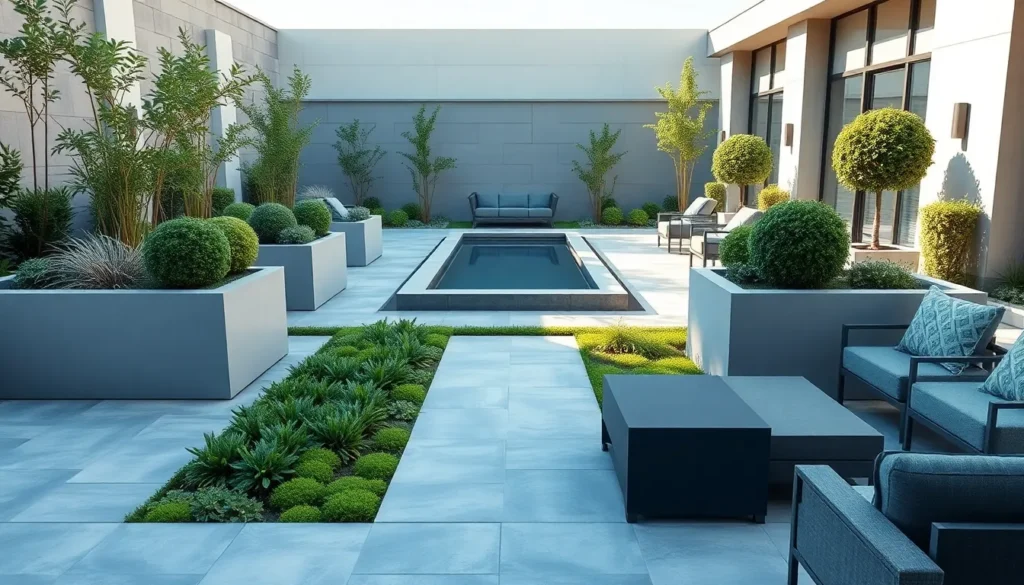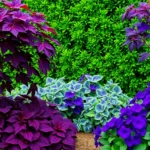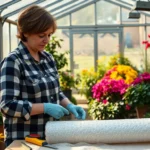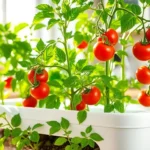We’ve all dreamed of transforming our outdoor spaces into stunning contemporary retreats that blur the lines between indoor and outdoor living. Modern garden design isn’t just about following trends – it’s about creating functional spaces that reflect our lifestyle while embracing clean lines, sustainable practices, and innovative materials.
Today’s contemporary gardens prioritize simplicity without sacrificing beauty. We’re seeing homeowners embrace minimalist plantings, geometric layouts, and multi-functional design elements that serve both aesthetic and practical purposes. From sleek water features to sculptural plant arrangements, these spaces become true extensions of our homes.
Whether you’re working with a compact urban balcony or sprawling suburban yard, contemporary garden design offers endless possibilities. We’ll explore how to incorporate modern materials like corten steel and concrete, select the perfect plants for year-round interest, and create outdoor rooms that seamlessly connect with your home’s architecture.
Contemporary Minimalist Garden Designs That Maximize Visual Impact
Contemporary minimalist gardens prove that less truly becomes more when every element serves a deliberate purpose. We create stunning outdoor spaces by focusing on simplicity and sophistication.
Clean Lines and Geometric Shapes
Straight pathways define contemporary garden boundaries while creating visual movement throughout the space. We use materials like concrete pavers, steel edging, and limestone strips to establish crisp borders that separate planted areas from hardscaping. Rectangle raised planters become focal points when positioned at strategic intervals along walkways.
Square water features add modern sophistication without overwhelming the design. We recommend installing shallow reflecting pools or geometric fountains that complement the garden’s angular theme. These features work especially well when positioned to reflect architectural elements from your home.
Triangular plant groupings create ever-changing visual interest while maintaining the minimalist aesthetic. We arrange plants in odd-numbered clusters using species like ornamental grasses, sculptural agaves, or boxwood spheres. This approach allows each plant to stand out individually while contributing to the overall geometric composition.
Monochromatic Color Schemes
Green foundation palettes form the backbone of minimalist garden design using various shades and textures of foliage. We select plants like Japanese forest grass, hostas, and ferns to create depth without introducing competing colors. This approach highlights the natural beauty of plant forms and structures.
White accent gardens provide striking contrast against dark backgrounds like black mulch or charcoal fencing. We incorporate white flowering plants such as gardenias, white roses, and ornamental kale to create sophisticated focal points. These gardens appear especially dramatic during evening hours with proper lighting.
Gray themed landscapes offer contemporary elegance through plants with silvery foliage like lamb’s ear, dusty miller, and artemisia. We pair these plants with gray gravel pathways and concrete elements to establish cohesive color flow. This palette works particularly well in regions with intense sunlight where silver plants naturally thrive.
Strategic Use of Negative Space
Open lawn areas serve as visual breathing room between planted sections and architectural features. We maintain these spaces as simple grass rectangles or substitute with alternative ground covers like clover or moss. The key lies in preserving these areas free from decorative elements that might clutter the design.
Gravel meditation zones create contemplative spaces that balance active garden areas with peaceful retreats. We use materials like decomposed granite, pea gravel, or river rock to establish these quiet zones. Adding a single sculptural element like a large boulder or modern art piece enhances the space without overwhelming it.
Vertical wall spaces become design opportunities when we leave them intentionally bare or minimally decorated. We might install a single piece of outdoor art or allow climbing plants to create natural patterns against clean surfaces. This restraint allows visitors to appreciate the garden’s carefully planned elements without visual competition.
Contemporary Water Features for Modern Outdoor Spaces
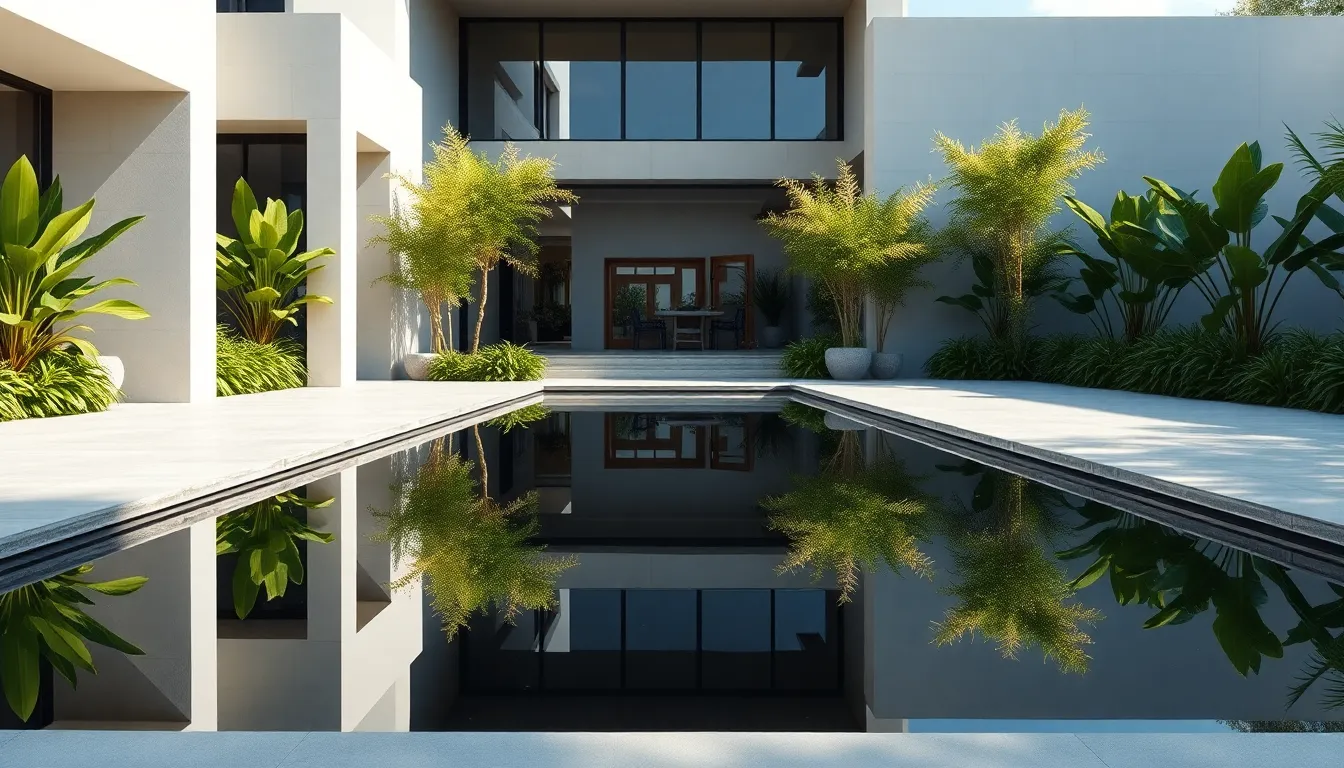
Water elements serve as powerful focal points that enhance the minimalist aesthetic we’ve established in contemporary garden design. These features complement clean architectural lines while introducing movement and tranquility to our outdoor spaces.
Sleek Rectangular Reflecting Pools
Rectangular reflecting pools create stunning ground-level installations that seamlessly integrate with modern industry architecture. We position these geometric water features at grade level to maintain visual continuity throughout the garden space. The mirrored surface acts as a natural light reflector, bouncing illumination across surrounding plantings and hardscape elements.
Simple shapes work best for contemporary designs, with rectangles offering the cleanest aesthetic impact. These pools require minimal maintenance while providing maximum visual drama through their still water surfaces. Strategic placement near seating areas or architectural features amplifies their meditative qualities and creates peaceful gathering spots.
Contemporary Fountain Walls
Vertical water features transform blank walls into ever-changing focal points using materials like stainless steel, natural stone, and concrete. We install these wall-mounted fountains to create smooth cascading sheets of water that flow down engineered surfaces. Individual spouts can be arranged in geometric patterns for added visual interest while maintaining the clean lines essential to modern design.
These fountain walls serve dual purposes as both sculptural elements and sound barriers in urban settings. Water flows consistently from hidden reservoir systems, creating soothing ambient noise that masks traffic sounds. Installation typically requires professional plumbing but results in dramatic architectural statements that enhance property values.
Modern Rain Chains and Water Sculptures
Rain chains offer functional alternatives to traditional downspouts while adding decorative elements to our contemporary gardens. We select materials like copper, zinc, or geometric shaped cups that guide water from rooftops to ground basins in visually appealing ways. These installations collect rainwater for garden irrigation while creating temporary water features during storms.
Water sculptures introduce artistic elements through abstract shapes and kinetic installations that move water in unexpected patterns. Standalone pieces incorporate pumps, LED lighting, and interactive components for enhanced visual effects. These sculptural features work especially well as centerpieces in minimalist garden designs where few elements compete for attention.
Contemporary Plant Selection for Low-Maintenance Beauty
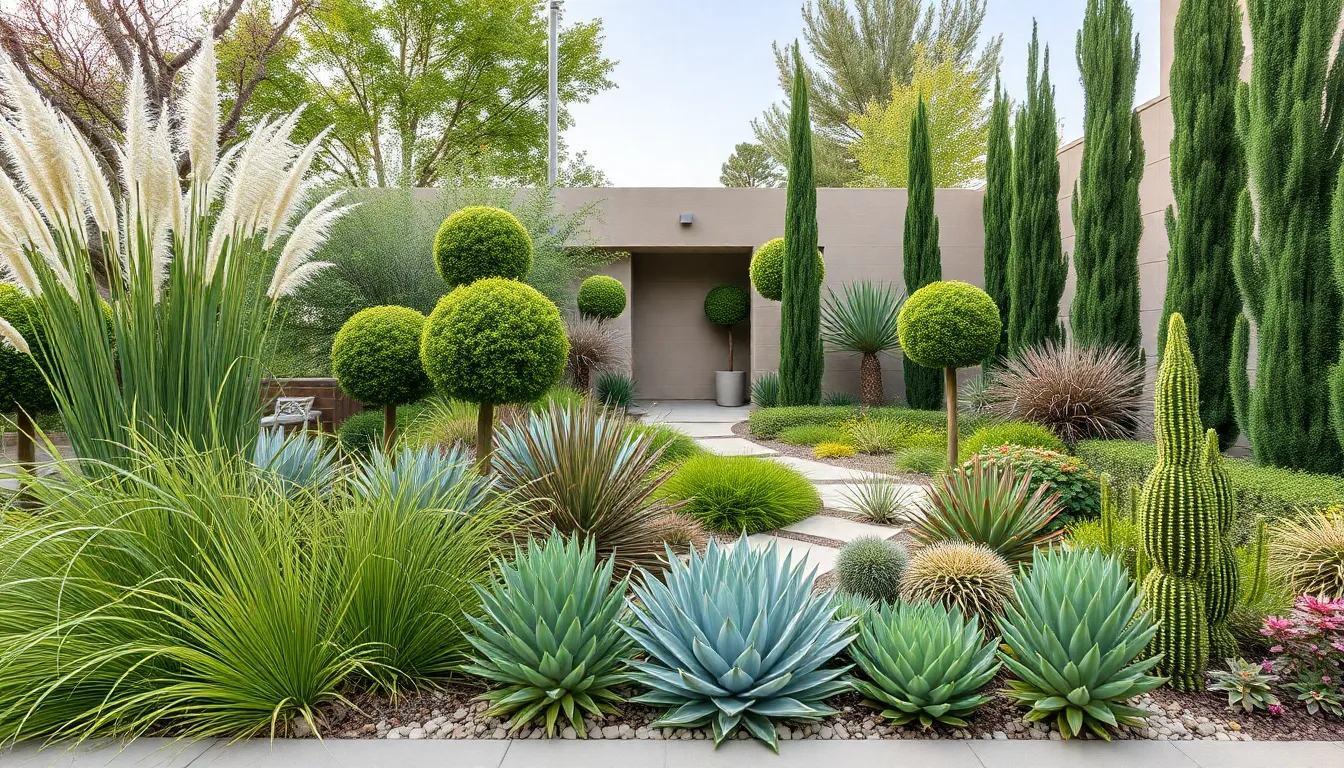
Selecting the right plants transforms contemporary gardens into stunning landscapes that require minimal upkeep while delivering maximum visual impact. We’ll explore three key categories that define modern plantings and create architectural beauty year round.
Architectural Grasses and Ornamental Plants
Feather reed grass creates vertical drama with its upright columns reaching 4-6 feet tall, while fountain grass adds graceful movement with its cascading plumes. These grasses provide texture and structure that remains attractive through multiple seasons without demanding frequent maintenance.
Ornamental plants like Japanese painted ferns and hostas offer bold foliage patterns that create striking contrasts against clean hardscaping materials. Their architectural qualities shine when planted in geometric groupings or linear arrangements that complement contemporary design principles.
Miscanthus varieties establish strong focal points with their tall, swaying stems and feathery seed heads that catch light beautifully. We recommend spacing these grasses strategically to frame pathways or create natural privacy screens in modern outdoor spaces.
Drought-Tolerant Succulents and Native Species
Agave and barrel cactus specimens serve as living sculptures that thrive with minimal watering, making them perfect for eco-friendly contemporary gardens. These succulents require watering only once every 2-3 weeks during growing season and virtually no care during winter months.
Native wildflowers like black-eyed Susans and purple coneflowers support local ecosystems while reducing maintenance demands significantly. Regional native plants adapt naturally to local climate conditions, eliminating the need for supplemental irrigation once established.
Sedum varieties create stunning ground cover that changes color throughout seasons, from green summer foliage to bronze and red autumn displays. We particularly favor Autumn Joy and Dragon’s Blood sedum for their ability to spread naturally and suppress weeds without aggressive maintenance.
Structured Topiary and Sculptural Plants
Boxwood spheres and geometric hedge designs provide clean architectural lines that define contemporary garden boundaries. These evergreen plants maintain their shape with just 2-3 pruning sessions per year, creating lasting structure without constant upkeep.
Columnar juniper trees establish vertical elements that complement modern home architecture while requiring minimal shaping or trimming. Their naturally narrow growth habit makes them ideal for framing entryways or creating living privacy walls in urban settings.
Spiral topiaries using privet or yew add artistic focal points that draw the eye and create conversation pieces in minimalist garden designs. We recommend positioning these sculptural elements at pathway intersections or as centerpieces in geometric planting beds to maximize their visual impact.
Contemporary Hardscaping Materials That Define Modern Gardens
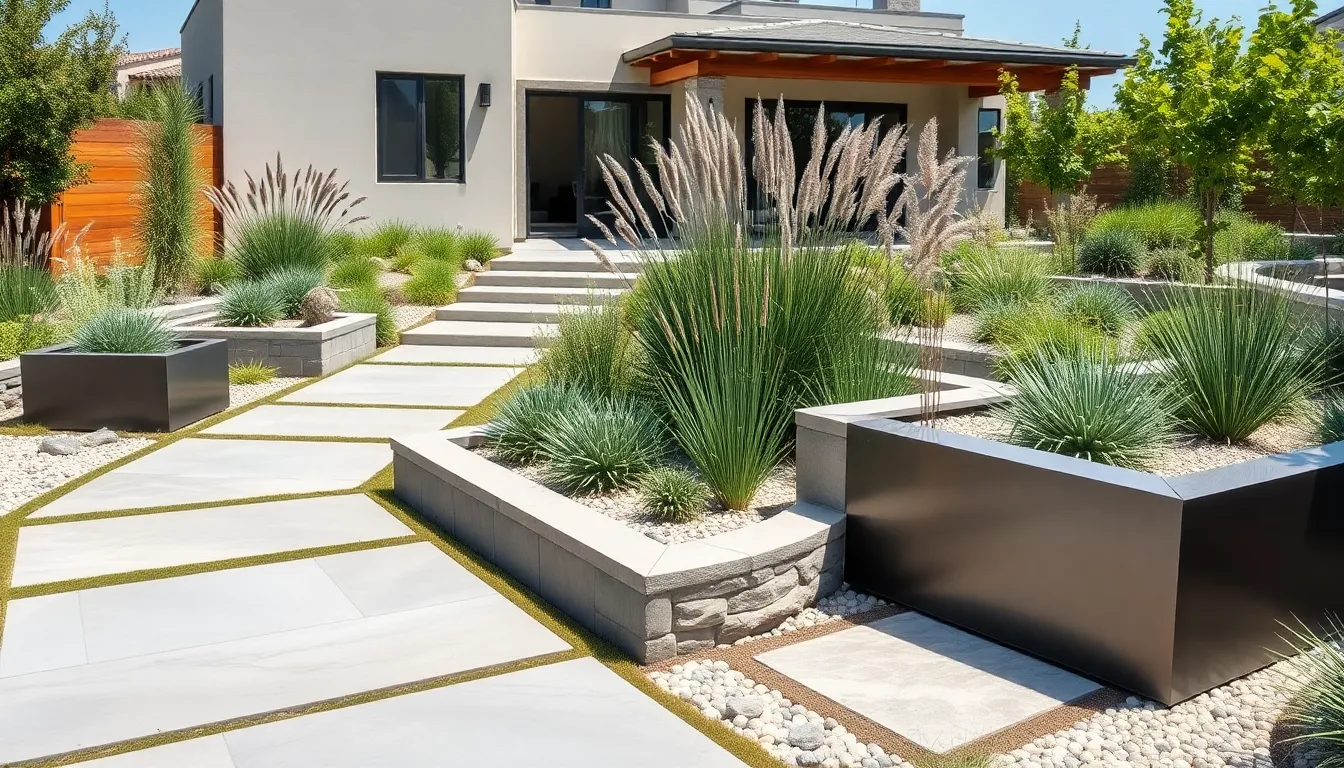
Material choices create the foundation for sophisticated outdoor spaces that seamlessly blend form and function. These contemporary hardscaping elements establish the structural backbone of modern garden design.
Polished Concrete and Steel Elements
Polished concrete delivers a sleek, industrial aesthetic that complements contemporary architecture perfectly. We see this material transforming garden pathways into striking linear features that connect different outdoor zones with precision. Steel elements provide dramatic vertical accents through pergolas, planters, and sculptural installations that age beautifully over time.
Contemporary designers combine these materials to create multi-level terraces and seating walls that serve both functional and artistic purposes. Polished concrete surfaces reflect light during day hours while steel accents cast intriguing shadows that change throughout the seasons. These materials require minimal maintenance while offering maximum visual impact in modern industry designs.
Steel planters elevated on concrete platforms create geometric garden beds that showcase architectural plants like ornamental grasses and succulents. The contrast between cool industrial materials and organic plant forms establishes the sophisticated tension that defines contemporary garden spaces.
Natural Stone with Clean Edges
Natural stone with precisely cut edges bridges the gap between organic beauty and modern geometric design principles. We recommend limestone, granite, and slate varieties that offer clean lines without sacrificing the authentic textures that connect gardens to their natural surroundings. These materials work exceptionally well for creating stepped pathways, retaining walls, and water feature surrounds.
Contemporary stonework emphasizes horizontal lines and rectangular forms that complement minimalist planting schemes. Uniform stone slabs create seamless transitions between indoor and outdoor living areas while maintaining visual continuity with modern home architecture.
Large format stone pavers eliminate busy joint patterns that can overwhelm contemporary plant selections. We often specify stones in neutral tones like charcoal gray and warm beige that provide sophisticated backdrops for colorful seasonal plantings or monochromatic green schemes.
Composite Decking and Modern Pavers
Composite decking materials offer exceptional durability while delivering the warm appearance of natural wood without ongoing maintenance requirements. We choose composite options in contemporary colors like graphite and driftwood that coordinate with modern exterior finishes and furniture selections.
Modern pavers in oversized formats create clean geometric patterns that enhance contemporary garden designs. Porcelain pavers resist staining and weathering while providing consistent colors that won’t fade over multiple seasons. These materials work particularly well for creating outdoor dining areas and entertainment zones that extend interior living spaces.
Contemporary paver installations focus on simple laying patterns like running bond or stack bond that emphasize clean lines rather than decorative complexity. We recommend pavers in dimensions like 24×24 inches or 12×24 inches that create substantial visual presence without overwhelming smaller garden spaces.
Contemporary Lighting Solutions for Dramatic Garden Ambiance
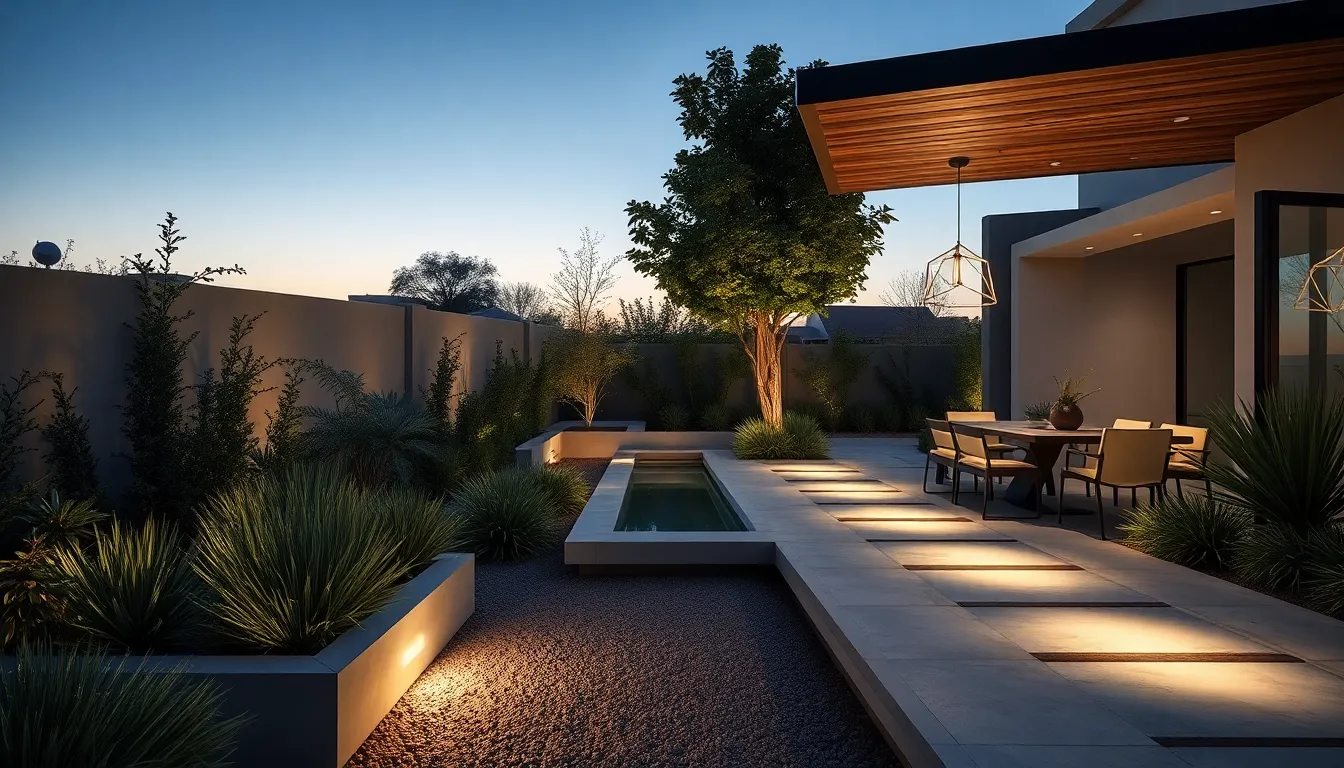
Effective lighting transforms contemporary gardens from daytime showcases into evening sanctuaries that extend outdoor living well into the night. Strategic illumination enhances the architectural elements we’ve carefully selected while creating new layers of visual interest and functionality.
LED Strip Lighting and Path Illumination
LED strip lighting offers unparalleled flexibility for highlighting the clean lines and geometric features that define our contemporary hardscaping. We can install these energy efficient systems along the edges of polished concrete planters, underneath steel seating walls, and within the grooves of modern composite decking to create subtle definition without overwhelming the minimalist aesthetic.
Path illumination using targeted LED fixtures serves dual purposes by ensuring safe navigation while drawing attention to key garden elements. Strategic placement along straight walkways emphasizes the geometric layouts we’ve established, while uplighting our architectural grasses like feather reed grass creates dramatic shadows against vertical surfaces.
Low voltage LED systems integrate seamlessly with our drought tolerant plantings, requiring minimal disruption to established root systems. These fixtures consume up to 80% less energy than traditional lighting options while providing consistent illumination for up to 25,000 hours of operation.
Modern Sculptural Light Fixtures
Contemporary sculptural lighting transforms functional illumination into artistic focal points that complement our structured topiary and clean architectural lines. Sleek cylindrical bollards made from brushed stainless steel or powder coated aluminum echo the materials we’ve used in our hardscaping while providing ambient lighting for gathering areas.
Geometric pendant lights suspended over outdoor dining zones create intimate conversation spaces that extend the indoor outdoor living concept. These fixtures often feature clean angular designs or minimalist globe shapes that harmonize with our monochromatic color schemes without competing for visual attention.
Wall mounted sconces with asymmetrical light distribution patterns add visual interest to blank vertical surfaces while highlighting textural elements like natural stone with clean edges. Modern designs often incorporate LED technology within sculptural housings that serve as decorative elements during daylight hours.
Smart Lighting Technology Integration
Smart lighting systems allow us to create ever-changing lighting scenes that adapt to different occasions and seasonal changes throughout the year. Programmable controllers can automatically adjust brightness levels, timing sequences, and color temperatures to enhance our carefully planned plantings and hardscape features.
Integration with home automation systems enables seamless control of outdoor lighting alongside indoor systems, reinforcing the connection between interior and exterior spaces. We can create preset scenes for entertaining, security, or meditation that complement the peaceful ambiance of our gravel meditation zones and reflecting pools.
Color changing LED technology offers seasonal flexibility, allowing warm white tones during autumn months and cooler temperatures during summer evenings. Motion sensors and daylight harvesting features ensure energy efficiency while maintaining the sophisticated aesthetic we’ve established through our contemporary material choices and minimalist plant selections.
Contemporary Outdoor Furniture and Seating Areas
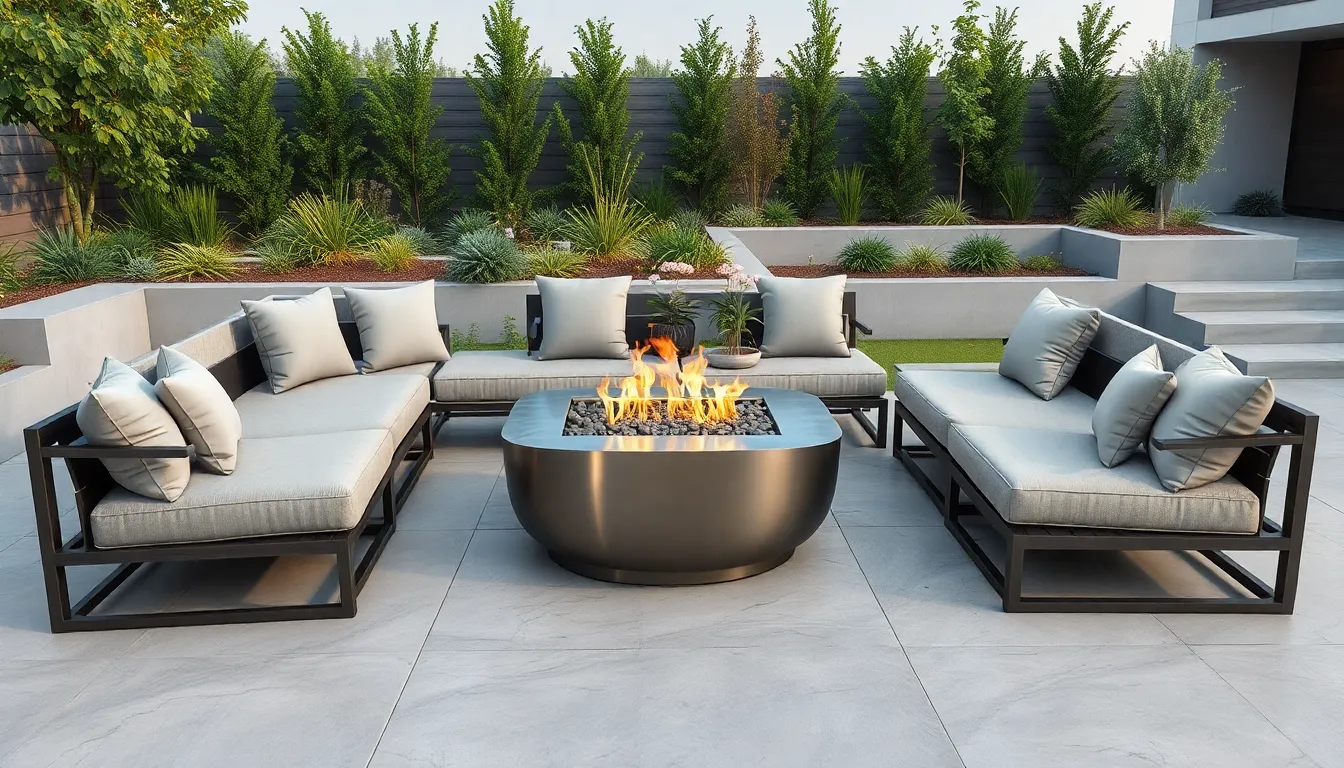
Modern outdoor furniture transforms our gardens into sophisticated living spaces that rival indoor comfort. We’re seeing a shift toward pieces that combine functionality with striking visual appeal.
Modular Seating Systems
Modular seating systems offer unmatched versatility for our contemporary gardens. We can customize arrangements according to our exact needs and available space, making these systems perfect for both intimate balconies and expansive patios. These innovative pieces typically feature weather-resistant materials like powder-coated aluminum that maintains its sleek appearance year-round.
Teak components provide natural durability while adding warmth to our modern outdoor spaces. High-performance synthetic fabrics designed specifically for outdoor conditions ensure our cushions and upholstery withstand sun, rain, and temperature fluctuations without fading or deteriorating. We appreciate how these systems adapt to different occasions, from casual family gatherings to formal outdoor dinner parties.
Fire Pits with Contemporary Design
Fire pits serve as stunning focal points that extend our garden’s usability well into cooler seasons. Contemporary designs incorporate materials such as stainless steel, concrete, and natural stone to create geometric shapes that complement our minimalist garden aesthetics. These features become the heart of our outdoor entertaining areas, drawing guests together while providing both warmth and visual drama.
Streamlined rectangular and circular forms replace traditional rustic designs, aligning perfectly with our clean-lined contemporary approach. We find that modern fire pits integrate seamlessly with our existing hardscaping materials, creating cohesive outdoor living rooms that feel intentionally designed rather than randomly assembled.
Weather-Resistant Modern Materials
Weather-resistant materials ensure our contemporary furniture maintains its sophisticated appearance even though constant exposure to the elements. Innovations in outdoor fabrics now provide performance that rivals indoor textiles while withstanding UV rays, moisture, and temperature extremes. Composite decking materials offer wood-like aesthetics without the maintenance requirements of traditional lumber.
Corten steel develops a protective patina that enhances rather than detracts from its industrial appeal. Synthetic rattan provides the texture and visual interest of natural wicker while offering superior durability and easy maintenance. Concrete furniture pieces bring sculptural elements to our seating areas, requiring minimal upkeep while providing years of reliable service that complements our minimalist design principles.
Contemporary Vertical Garden Ideas for Small Spaces
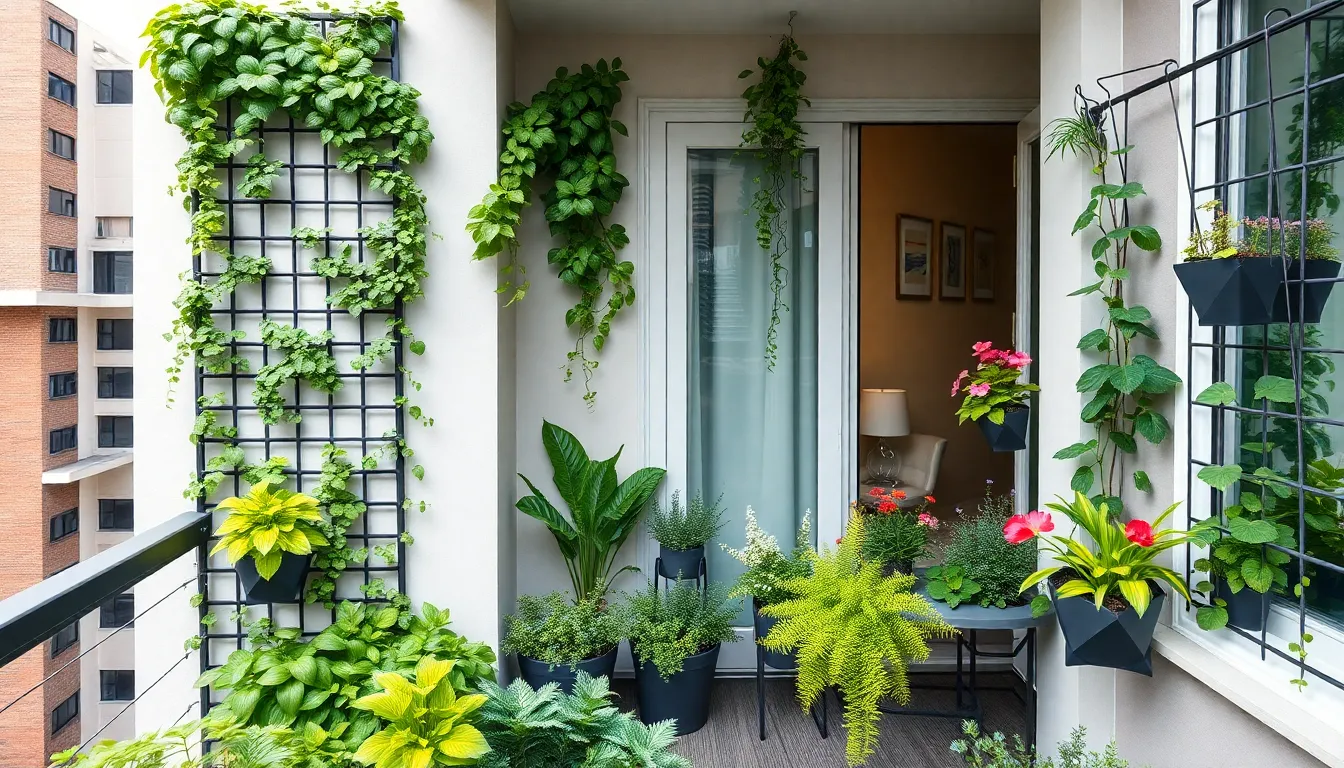
Vertical growing transforms limited square footage into lush, productive spaces that maximize every inch of our outdoor areas. These innovative answers work perfectly for urban balconies, narrow side yards, and compact patios where traditional horizontal planting isn’t feasible.
Living Walls and Green Screens
Living walls revolutionize small space gardening by creating stunning vertical displays that serve multiple functions. We’re seeing incredible advances in modern living wall systems that include built-in irrigation and drainage components, making maintenance surprisingly simple for busy homeowners.
Green screens offer exceptional privacy answers while maximizing biodiversity in compact areas. These installations support diverse plant communities that create resilient ecosystems, providing ecological benefits far beyond their footprint. Professional systems now integrate smart watering technology that monitors soil moisture and adjusts irrigation automatically.
Maximalist planting designs within living walls incorporate various species that enhance local wildlife habitats. We can combine ferns, succulents, herbs, and flowering plants in single installations to create year-round visual interest. These diverse plantings support beneficial insects while reducing our environmental impact through improved air quality.
Modern Trellis Systems
Geometric trellis designs add architectural interest while supporting climbing plants in sophisticated ways. Metal frameworks create clean lines that complement contemporary outdoor furniture and hardscaping materials we’ve discussed previously. These structures work beautifully with clematis, climbing roses, or edible vines like grapes and hops.
Innovative materials expand our trellis options beyond traditional wood to include powder-coated steel, aluminum, and recycled composite materials. These modern options resist weather damage while maintaining their aesthetic appeal for decades. We’re particularly impressed with modular trellis systems that adapt to different plant growth patterns and seasonal changes.
Recycled plastic trellis options align with sustainable garden practices while offering durability and design flexibility. These eco-friendly alternatives come in various colors and patterns that integrate seamlessly with existing garden elements. Installation becomes straightforward with pre-designed mounting systems that attach to walls, fences, or freestanding posts.
Hanging Gardens with Geometric Planters
Geometric planter shapes create visual drama in hanging installations that transform overhead spaces into growing areas. Spherical planters work exceptionally well for trailing plants like pothos or string of pearls, while cubic designs suit structured plantings with herbs or small flowering annuals.
Hexagonal hanging systems offer modular flexibility that allows us to expand or reconfigure our aerial gardens as needs change. These multi-sided planters create interesting shadow patterns that add another design layer to our outdoor spaces. We can group different sizes together for ever-changing compositions that draw the eye upward.
Sustainable planter materials include bamboo fiber composites, recycled metals, and reclaimed wood that align with eco-friendly garden trends. These options reduce environmental impact while providing the durability needed for hanging applications. Smart drainage systems prevent water damage to patios below while ensuring plants receive adequate moisture without oversaturation.
Contemporary Garden Technology and Smart Features
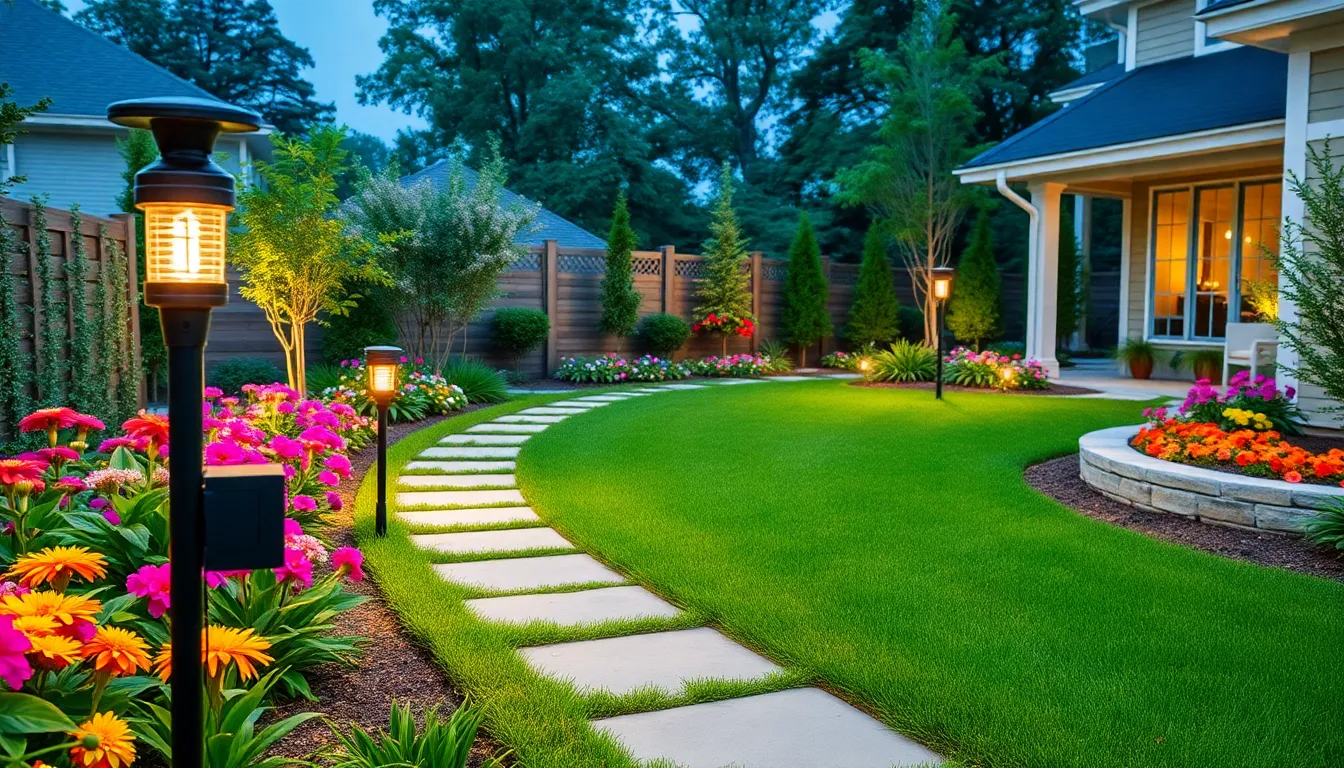
Technology integration elevates contemporary gardens from static landscapes into ever-changing, responsive outdoor environments. Modern innovations transform traditional gardening into efficient, data-driven experiences that enhance both plant health and user convenience.
Automated Irrigation Systems
Sensor-driven irrigation systems revolutionize water management by delivering precise moisture levels to different garden zones. These intelligent networks use soil moisture sensors and weather data to automatically adjust watering schedules, ensuring plants receive optimal hydration without waste. Smart controllers connect to weather services, postponing irrigation during rain events and increasing frequency during drought conditions.
Zone-exact programming allows customization for different plant types, from drought-tolerant succulents requiring minimal water to moisture-loving ferns needing consistent irrigation. Modern systems integrate with smartphone apps, enabling remote monitoring and control from anywhere. Advanced models feature drip irrigation components that target root zones directly, reducing water consumption by up to 50% compared to traditional sprinkler methods.
Timer-based scheduling coordinates with optimal watering windows, typically during early morning hours when evaporation rates are lowest. Professional-grade systems include pressure monitoring and leak detection capabilities, alerting users to maintenance needs before problems escalate. Installation flexibility accommodates various garden layouts, from linear borders to curved planting beds.
Smart Garden Monitoring Tools
Real-time monitoring devices track essential environmental conditions including temperature, humidity, and soil pH levels throughout different garden zones. Wireless sensors transmit data continuously to centralized hubs, creating comprehensive environmental profiles that inform gardening decisions. Multi-parameter monitoring systems measure light exposure, helping gardeners optimize plant placement for maximum photosynthetic efficiency.
Smartphone connectivity transforms raw sensor data into actionable insights through user-friendly dashboard interfaces. Professional-grade monitors detect subtle changes in plant health indicators, alerting gardeners to potential issues before visible symptoms appear. Cloud-based data storage enables long-term trend analysis, revealing seasonal patterns and helping predict optimal planting and maintenance schedules.
Battery-powered sensors operate independently for months, requiring minimal maintenance while providing continuous monitoring coverage. Advanced systems integrate with automated irrigation controllers, creating closed-loop management that responds automatically to changing conditions. Weather station integration combines on-site measurements with regional forecast data, improving prediction accuracy for garden management decisions.
Solar-Powered Garden Elements
Solar technology powers contemporary garden features while reducing energy costs and environmental impact across outdoor spaces. Photovoltaic panels integrated into garden structures generate clean electricity for lighting, water features, and monitoring systems throughout daylight hours. Energy storage batteries ensure continuous operation during evening hours and cloudy periods.
LED lighting systems powered by solar panels illuminate pathways, accent plants, and architectural features without increasing utility bills. Modern solar fountains circulate water continuously, creating soothing sounds and visual movement while maintaining energy independence. Pump systems for water features and irrigation backup operate reliably using stored solar energy, ensuring garden functionality during power outages.
Installation simplicity characterizes most solar garden products, requiring no electrical wiring or professional installation for basic applications. Weather-resistant designs withstand outdoor conditions while maintaining consistent performance across seasons. Smart solar controllers optimize energy collection and usage, extending operational hours and improving system efficiency for year-round garden enhancement.
Conclusion
Contemporary garden design offers endless possibilities for creating sophisticated outdoor spaces that reflect our modern lifestyles. By embracing minimalist principles and innovative materials we can transform any space into a functional retreat that bridges indoor and outdoor living.
The key lies in balancing simplicity with purposeful design choices. Whether we’re working with cutting-edge technology or sustainable materials each element should contribute to a cohesive vision that enhances our daily experience.
These contemporary approaches prove that exceptional garden design isn’t about complexity—it’s about creating spaces that inspire us while requiring minimal maintenance. Start with one element that resonates with your style and build from there to create your own modern outdoor sanctuary.
Frequently Asked Questions
What defines modern garden design?
Modern garden design emphasizes clean lines, geometric layouts, and minimalist aesthetics that blend indoor and outdoor living. It focuses on creating functional, contemporary spaces using sustainable practices, innovative materials, and architectural plantings. The design philosophy prioritizes simplicity, sophistication, and multi-functional elements that reflect personal lifestyles while maintaining visual impact through strategic use of negative space.
What are the best plants for contemporary minimalist gardens?
Contemporary gardens feature three key plant categories: architectural grasses like feather reed grass, drought-tolerant succulents and natives such as agave and black-eyed Susans, and structured topiary plants including boxwood spheres. These selections provide texture, structure, and year-round interest while requiring minimal maintenance and supporting eco-friendly gardening practices.
What materials work best for modern garden hardscaping?
Modern gardens utilize polished concrete and steel for industrial aesthetics, natural stone with clean edges for organic-geometric balance, and composite decking with modern pavers for durability. These materials create multi-level terraces, seating walls, and entertainment zones that seamlessly connect indoor and outdoor spaces while maintaining sophisticated, contemporary appeal.
How does lighting enhance contemporary garden design?
Contemporary garden lighting uses LED strip lighting for geometric feature accent, targeted path illumination for safety, and sculptural light fixtures as artistic focal points. Smart lighting technology integration allows customizable scenes for different occasions, transforming outdoor spaces into evening sanctuaries while reinforcing the connection between indoor and outdoor living areas.
What furniture styles complement modern garden design?
Modern gardens feature modular seating systems for versatility, contemporary fire pits with geometric designs as focal points, and weather-resistant materials that maintain sophisticated aesthetics. These pieces transform gardens into functional living spaces, extending usability into cooler seasons while aligning with minimalist design principles and providing both style and durability.
How can small spaces incorporate contemporary garden design?
Small spaces can utilize vertical garden solutions including living walls, green screens for privacy, modern trellis systems with architectural interest, and hanging gardens with geometric planters. These vertical growing methods maximize limited areas, create visual drama, and provide ecological benefits while maintaining the clean, sophisticated aesthetic of contemporary design.
What smart technology features enhance modern gardens?
Contemporary gardens incorporate automated irrigation systems with sensors for optimal water management, smart monitoring tools that track environmental conditions, and solar-powered elements for lighting and water features. These technologies create responsive outdoor environments, minimize resource waste, enhance sustainability, and provide real-time data for informed gardening decisions.

